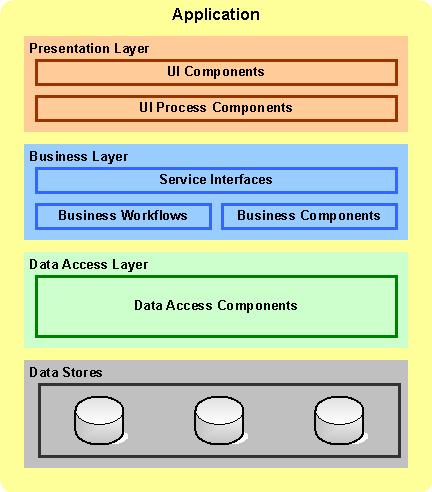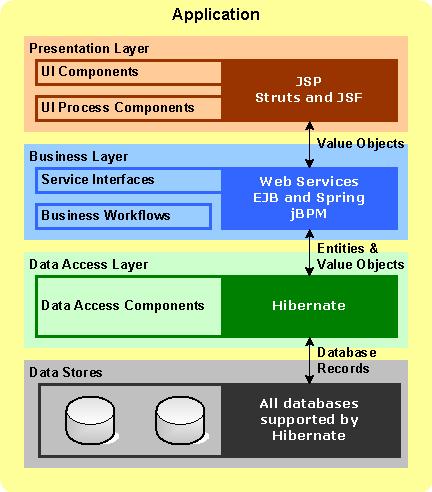Application Architecture
Modern enterprise applications are built using several components connected to one
another, each providing a specific functionality. Components that perform similar
functions are generally grouped into layers. These layers are further organized
as a stack where components in a higher layer use the services of components in
a lower layer. A component in a given layer will generally use the functionality
of other components in its own layer or the layers below it. The diagram below shows
a popular layer structure for an enterprise application.

-
Presentation Layer:
The presentation layer contains components
needed to interact with the user of the application. Examples of such components
are web pages, rich-client forms, user interaction process components etc.
-
Business Layer:
The business layer encapsulates the core business
functionality of the application. Simple business functions can be implemented using
stateless components, whereas complex, long-running transactions can be implemented
using stateful workflows. The business components are generally front-ended by a
service interface that acts as a facade to hide the complexity of the business logic.
This is commonly known as Service-Oriented Architecture (SOA).
-
Data Access Layer:
The data access layer provides a simple API
for accessing and manipulating data. The components in this layer abstract the semantics
of the underlying data access technology thus allowing the business layer to focus
on business logic. Each component typically provides methods to perform Create,
Read, Update, and Delete (CRUD) operations for a specific business entity.
-
Data Stores:
Enterprise applications store their data in one or
more data stores. Databases and file systems are two very common types of data stores.
Note that layers are simply logical groupings of components that make up an application.
How these layers are actually deployed on physical machines, however, can vary widely
depending on several factors. In the simplest case, all the layers can reside on
one machine. In a slightly more complex scenario, the presentation layer can reside
on one machine, the business and data access layers on a second machine, and the
database on a third machine. More elaborate scenarios are possible; for example,
a high traffic web site can deploy the presentation layer on a web farm consisting
of tens of machines.
Architecture of AndroMDA Generated Applications
Now that we understand the basic concepts behind modern enterprise applications,
let's discuss how AndroMDA implements these concepts. AndroMDA takes as its input
a business model specified in the Unified Modeling Language (UML) and generates
significant portions of the layers needed to build a Java application. AndroMDA's
ability to automatically translate high-level business specifications into production
quality code results in significant time savings when implementing Java applications.
The diagram below maps various application layers to Java technologies supported
by AndroMDA.

-
Presentation Layer:
AndroMDA currently offers two technology options
to build web based presentation layers:
Struts
and
JSF. It accepts UML activity diagrams as input to specify page flows
and generates Web components that conform to the Struts or JSF frameworks.
-
Business Layer:
The business layer generated by AndroMDA consists
primarily of services that are configured using the
Spring Framework. These services are implemented manually
in AndroMDA-generated blank methods, where business logic can be defined. These
generated services can optionally be front-ended with EJBs, in which case the services
must be deployed in an EJB container
(e.g.,JBoss). Services can also be exposed as Web Services, providing
a platform independent way for clients to access their functionality. AndroMDA can
even generate business processes and workflows for the
jBPM
workflow engine (part of the JBoss product line).
-
Data Access Layer:
AndroMDA leverages the popular object-relational
mapping tool called
Hibernate
to generate the data access layer for applications. AndroMDA does this by generating
data access objects (DAOs) for entities defined in the UML model. These data access
objects use the Hibernate API to convert database records into objects and vice-versa.
AndroMDA also supports
EJB3/Seam
for data access layer (pre-relase).
-
Data Stores:
Since AndroMDA generated applications use Hibernate
to access the data, you can use any of the databases supported by Hibernate.
Data Propagation Between Layers
In addition to the concepts discussed previously, it is important to understand
how data propagates between various layers of an application. Follow along the diagram
above as we start from the bottom up.
As you know, relational databases store data as records in tables. The data access
layer fetches these records from the database and transforms them into objects that
represent entities in the business domain. Hence, these objects are called business
entities.
Going one level up, the data access layer passes the entities to the business layer
where business logic is performed.
The last thing to discuss is the propagation of data between the business layer
and the presentation layer, for which there are two schools of thought. Some people
recommend that the presentation layer should be given direct access to business
entities. Others recommend just the opposite, i.e. business entities should be off
limits to the presentation layer and that the business layer should package necessary
information into so-called "value objects" and transfer these value objects to the
presentation layer. Let's look at the pros and cons of these two approaches.
The first approach (entities only, no value objects) is simpler to implement. You
do not have to create value objects or write any code to transfer information between
entities and value objects. In fact, this approach will probably work well for simple,
small applications where the the presentation layer and the service layer run on
the same machine. However, this approach does not scale well for larger and more
complex applications. Here's why:
- Business logic is no longer contained in the business layer. It is tempting to freely
manipulate entities in the presentation layer and thus spread the business logic
in multiple places -- definitely a maintenance nightmare. In case there are multiple
front-ends to a service, business logic must be duplicated in all these front-ends.
In addition, there is no protection against the presentation layer corrupting the
entities - intentionally or unintentionally!
- When the presentation layer is running on a different machine (as in the case of
a rich client), it is very inefficient to serialize a whole network of entities
and send it across the wire. Take the example of showing a list of orders to the
user. In this scenario, you really don't need to transfer the gory details of every
order to the client application. All you need is perhaps the order number, order
date and total amount for each order. If the user later wishes to see the details
of a specific order, you can always serialize that entire order and send it across
the wire.
- Passing real entities to the client may pose a security risk. Do you want the client
application to have access to the salary information inside the Employee object
or your profit margins inside the Order object?
Value objects provide a solution for all these problems. Yes, they require you to
write a little extra code; but in return, you get a bullet-proof business layer
that communicates efficiently with the presentation layer. You can think of a value
object as a controlled view into one or more entities relevant to your client application.
Note that AndroMDA provides some basic support for translation between entities
and value objects, as you will see in the tutorial.
Services and Hibernate Sessions
Another key concept of AndroMDA-generated applications is the strong association
between service methods (i.e., operations exposed by a service) and Hibernate sessions.
But before we introduce this concept, we must lay out some ground work. The Hibernate
session is a runtime object that allows an application to create, read, update and
delete entities in the data store. As long as the session is "open", these entities
are attached to the session and you can navigate from one entity to another using
relationships between them. If a related entity is not yet in memory, Hibernate
will automatically pull it in for you (this is called "lazy loading"). However as
soon you close the Hibernate session, the entities that exist in memory are considered
to be "detached"; i.e. Hibernate no longer knows about them. You are free to hold
references to such entities, but Hibernate will no longer pull in associated entities
if they don't exist in memory already. If you accidentally try to access such associated
entities, you will get a Hibernate LazyInitializationException.
Now that we understand this background material, let us discuss the relationship
between a service method and a Hibernate session. When a client application calls
a service method, a new Hibernate session is opened automatically -- you do not
have to write any code to do this. Similarly, when the service method exits, the
associated Hibernate session is closed automatically. In other words, the lifespan
of a Hibernate session is bounded by the beginning and ending of a service method
call. Consequently, entities are attached to Hibernate session for the entire duration
of the service call, but are detached from this session as soon as the service call
ends. As a result, if your service method returns raw entities, the client must
be extra careful not to access related entities that are not in memory already.
You can avoid all this mess by following the recommendation in the earlier section;
that is, transfer all relevant information into value objects while the session
is still open, and pass these value objects back to your caller as a return value.
In general, think of a service method as a logical transactional boundary - do everything
you need to do within the method and then return the results as value objects.
Another implication of the strong association between a service method and a Hibernate
session is that client applications should not try to bypass the service layer and
interact directly with the lower layers. You may be able to brute force your way
into one data access object, but sooner or later you will get into trouble!
What's Next?
Now that you understand the basic tenets of AndroMDA, let's describe the sample
application we will implement in this tutorial. Click here
to get started.


